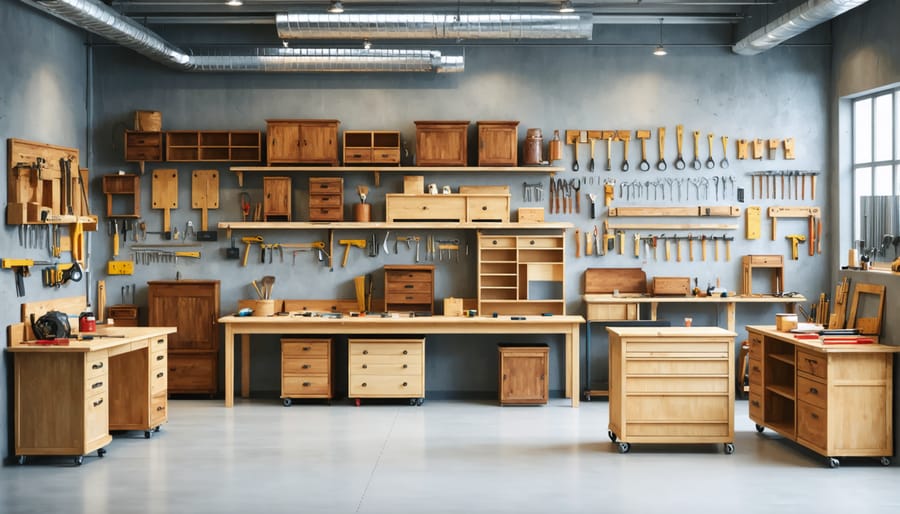
Transform your furniture repair business into a well-oiled machine by mastering the five fundamental areas that drive sustainable growth and profitability. From crafting precision repair solutions to building lasting customer relationships, successful furniture restoration businesses thrive when these core functions work in harmony. Whether you’re an established shop looking to scale or a new entrepreneur entering the market, understanding how operations, marketing, finance, human resources, and customer service intersect creates a foundation for excellence in the furniture repair industry.
Each functional area represents a vital piece of your business puzzle, contributing unique strengths while supporting overall organizational goals. Operations ensures quality repairs and efficient workflow. Marketing connects your expertise with customers who need it. Finance maintains healthy cash flow and profitability. Human resources builds and nurtures your skilled team. Customer service transforms one-time repairs into lasting relationships.
By optimizing these five pillars, furniture repair businesses can deliver exceptional craftsmanship while building a sustainable, profitable enterprise that stands out in a competitive market. Let’s explore how each functional area contributes to your success and learn practical strategies for enhancement and growth.

Effective workflow optimization is crucial for any furniture repair business’s success. By streamlining repair processes, companies can maximize productivity while maintaining high-quality service standards.
Start by implementing a digital scheduling system that allows for real-time job tracking and resource allocation. This enables technicians to efficiently plan their routes and manage multiple repairs while minimizing travel time between locations. Consider factors such as job complexity, technician expertise, and geographic location when assigning work orders.
Resource allocation should account for both human capital and material inventory. Maintain an organized inventory system that tracks supplies and equipment, ensuring necessary materials are always available when needed. This prevents costly delays and helps maintain customer satisfaction through timely project completion.
Establish clear communication channels between office staff, technicians, and customers. Use automated notifications to keep clients informed about appointment times, technician arrival, and project status updates. This transparency builds trust and reduces the time spent on routine follow-ups.
Consider implementing a priority-based scheduling system that accounts for urgent repairs, warranty work, and regular maintenance. This helps balance immediate customer needs with long-term business goals while maintaining steady workflow throughout the day. Regular analysis of completion times and customer feedback can help identify areas for further optimization and improvement.
Quality standards serve as the foundation of every successful furniture repair operation. By implementing and maintaining rigorous benchmarks, businesses ensure consistent, high-quality results that build customer trust and enhance reputation. The cornerstone of these standards includes detailed repair protocols, craftsman certification requirements, and regular quality audits.
Every repair project begins with a comprehensive assessment using standardized evaluation forms. These forms document damage types, repair methods, and materials needed, ensuring nothing is overlooked. Technicians follow step-by-step procedures for common repairs, from leather restoration to frame reinforcement, maintaining consistency across all service locations.
Quality control checkpoints are established at critical stages of the repair process. Before-and-after documentation, including detailed photographs, helps track repair progress and verify that work meets established standards. This documentation also serves as valuable training material and proof of service quality for customers and insurance providers.
Regular skill assessments and ongoing training programs keep technicians current with industry best practices and new repair techniques. Monthly quality reviews examine completed projects, identifying areas for improvement and celebrating exceptional work. This feedback loop ensures continuous improvement in service delivery.
Customer satisfaction surveys provide additional quality metrics, measuring not just repair outcomes but also service experience. By maintaining these rigorous standards, furniture repair businesses can deliver consistent, professional results that exceed customer expectations and drive long-term success.
Effective pricing strategies and cost management are crucial for the success of any furniture repair business. Setting profitable repair rates requires careful consideration of multiple factors, including material costs, labor hours, overhead expenses, and market competition.
Start by conducting a thorough analysis of your direct costs, including supplies, tools, and materials needed for repairs. Track these expenses meticulously to ensure accurate job costing. Labor costs should reflect both the skill level required and the time invested in each project, including preparation and cleanup.
Consider implementing a tiered pricing structure based on project complexity and urgency. This allows flexibility while maintaining profitability across different service categories. Regular monitoring of your profit margins helps identify which services are most profitable and where adjustments may be needed.
Don’t forget to factor in overhead costs such as rent, utilities, insurance, and marketing expenses when calculating your rates. A common mistake is underpricing services by focusing solely on direct costs. Aim for a healthy profit margin that sustains business growth while remaining competitive in your market.
Regular review of your pricing strategy is essential. Monitor changes in supplier costs, analyze competitor pricing, and gather customer feedback to ensure your rates remain both profitable and market-appropriate. Consider offering package deals or maintenance plans to create additional revenue streams while providing value to customers.

Maintaining healthy cash flow is crucial for the sustained success of your furniture repair business. Think of cash flow as the lifeblood that keeps your operations running smoothly – from purchasing supplies and materials to covering payroll and overhead expenses.
To effectively manage your cash flow, start by creating detailed monthly forecasts that account for both predictable income from regular clients and seasonal fluctuations in business. Consider implementing a mix of payment options, including upfront deposits for large restoration projects, which can help maintain steady cash flow while covering initial material costs.
Smart inventory management plays a vital role in cash flow health. Stock essential repair materials in quantities that balance immediate needs with storage costs, and negotiate favorable payment terms with suppliers when possible. This approach helps prevent both stockouts and excess inventory that ties up working capital.
Monitor your accounts receivable closely and establish clear payment policies. While maintaining positive client relationships is important in the furniture repair industry, prompt invoicing and following up on overdue payments are essential business practices. Consider offering early payment discounts to incentivize faster payments from commercial clients.
Maintain an emergency fund equivalent to at least three months of operating expenses. This buffer provides peace of mind and ensures your business can weather unexpected challenges or take advantage of growth opportunities without compromising day-to-day operations.
In today’s digital landscape, establishing and maintaining a strong online presence is crucial for furniture repair businesses. This functional area encompasses website optimization, social media management, and digital marketing strategies that showcase your craftsmanship and attract potential clients.
A well-designed website serves as your digital storefront, featuring before-and-after galleries of your restoration work and detailed service descriptions. Implement search engine optimization (SEO) techniques to improve visibility when customers search for furniture repair services in your area. Regular blog posts about furniture care tips and restoration projects help establish your expertise while driving organic traffic.
Social media platforms like Instagram and Pinterest are particularly effective for furniture repair businesses, as they allow you to showcase your work visually. Share transformation stories, time-lapse videos of repairs, and customer testimonials to build trust and engagement. Maintain consistent branding across all platforms to reinforce your professional image.
Email marketing campaigns keep past customers informed about your services and special offers, while online review management helps build credibility. Invest in professional photography to capture the quality of your work, and consider implementing a simple online booking system to streamline customer scheduling.
Monitor your digital analytics regularly to understand customer behavior and adjust your strategy accordingly, ensuring your online presence effectively supports business growth.
Customer Relationship Management (CRM) in the furniture repair industry goes beyond simply fixing damaged pieces – it’s about building lasting connections with clients that foster loyalty and repeat business. By maintaining detailed customer histories, including repair preferences, furniture types, and communication patterns, businesses can provide personalized service that exceeds expectations.
Effective CRM involves implementing systems to track customer interactions, from initial inquiries to follow-up maintenance requests. This includes utilizing digital tools to schedule appointments, send maintenance reminders, and gather feedback after service completion. Successful furniture repair businesses often establish regular communication channels through email newsletters, social media updates, and seasonal maintenance tips.
Building strong relationships also means being proactive in addressing customer concerns and maintaining transparency throughout the repair process. This might involve sharing progress photos, providing detailed estimates, and offering care recommendations to prevent future damage. Many successful businesses implement loyalty programs, offering returning customers preferred scheduling or discounted maintenance services.
Regular feedback collection through surveys and follow-up calls helps identify areas for improvement while demonstrating commitment to customer satisfaction. This information can be invaluable for refining services and training staff to better meet client needs.
Building a skilled repair team is crucial for delivering quality furniture restoration services. The success of your business largely depends on the expertise and reliability of your technicians, making effective human resources management essential.
Start by creating detailed job descriptions that outline required skills, experience levels, and personality traits. Look for candidates with a combination of technical proficiency and customer service abilities, as they’ll be interacting directly with clients. Consider both experienced professionals and apprentices to build a diverse team.
Implement a structured interview process that includes practical skills assessments. Have candidates demonstrate their repair techniques on test pieces to evaluate their craftsmanship. This hands-on approach helps identify those who truly possess the necessary skills versus those who simply interview well.
Develop a comprehensive training program that covers both technical skills and company procedures. Partner new hires with experienced technicians through a mentorship system, allowing them to learn specialized techniques while maintaining quality standards. Regular workshops and skill-development sessions keep your team updated on new restoration methods and materials.
Employee retention is crucial in this specialized field. Offer competitive compensation packages and create clear career advancement paths. Consider implementing a tiered certification system that rewards ongoing education and skill improvement. Recognition programs that highlight exceptional work help maintain motivation and job satisfaction.
Foster a culture of collaboration and knowledge sharing. Regular team meetings provide opportunities to discuss challenging projects, share solutions, and celebrate successes. This approach not only improves service quality but also builds team cohesion and job satisfaction.
Safety training should be a cornerstone of your human resources strategy. Ensure all team members are well-versed in proper handling of tools, chemicals, and materials. Regular safety refresher courses and maintaining updated certification requirements protect both your employees and your business.

In the furniture repair and restoration business, maintaining a reliable supply chain is crucial for delivering quality service. Effective inventory management ensures you have the right materials when needed, preventing project delays and maintaining customer satisfaction. Managing supplier relationships becomes particularly important when sourcing specialized materials like period-specific hardware or rare wood species.
Quality control in material procurement directly impacts your finished work. Establishing clear quality standards for incoming materials, from wood and fabrics to finishes and adhesives, helps maintain consistency in your repairs and restorations. Regular supplier evaluations ensure they meet these standards consistently.
Successful inventory management requires balancing stock levels with demand. While overstocking ties up capital and storage space, understocking can lead to missed opportunities and disappointed customers. Many furniture repair businesses implement just-in-time inventory systems for common materials while maintaining strategic reserves of harder-to-source items.
Technology plays a vital role in modern supply chain management. Digital inventory tracking systems help monitor stock levels, forecast needs, and automate reordering processes. These tools can also track material costs and usage patterns, providing valuable insights for business planning and pricing strategies.
Building strong relationships with multiple suppliers provides backup options when primary sources face shortages or delays. This redundancy helps ensure business continuity and maintains service quality even during supply chain disruptions. Regular communication with suppliers keeps you informed about new products, market changes, and potential supply issues before they affect your operations.
Understanding and effectively managing the five functional areas of business is crucial for success in the furniture repair and restoration industry. By maintaining a balanced focus on operations, marketing, finance, human resources, and management, you can build a sustainable and profitable enterprise. Start by evaluating your current performance in each area, identifying gaps, and creating specific action plans for improvement. Consider implementing regular reviews of these functional areas and establishing key performance indicators to track progress. Remember that these areas are interconnected – improvements in one often lead to positive changes in others. Take the first step today by assessing your strongest and weakest areas, then prioritize your efforts accordingly. With dedicated attention to these core business functions, you’ll be better positioned to serve your customers, support your team, and grow your furniture repair business.